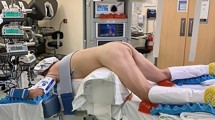Abstract
Background
Transanal minimally invasive surgery (TAMIS) offers intra-luminal full-thickness excision of rectal neoplasia. Robotic TAMIS (RT) allows for greater versatility in motion while operating in the limited space of the rectum. We present our experience with this technique in practice using the DaVinci Xi™ platform.
Method
This is a multi-institutional retrospective analysis for patient undergoing Robotic TAMIS for resection of rectal lesions at two tertiary referral hospitals in the United States. Morbidity, mortality, anatomic measurement, and final pathology were analyzed.
Results
Thirty-four patients planned for Robotic TAMIS were identified. Average follow-up was 188 days. The average BMI was 29.5 ± 5.9. All patients had an American Society of Anesthesiologist (ASA) Class of 2 or greater and 21 (62%) were ASA 3 or greater. Rectal lesions located from 2 to 15 cm from the dentate line were successfully resected. Lesions up to 4.5 cm in the longest dimension were successfully resected. The average operative time was 100 ± 70 min, which correlated to a robotic console time of 76 ± 67 min. Patients were placed in Lithotomy in 32 (94%) cases and were prone in only 2 (6%) cases. There were no intraoperative complications or conversions to another technique. The only postoperative complication was a medically managed Clostridium difficile infection in 1 patient. Three patients were upstaged to T2 on final pathology and underwent successful formal resections. BMI was a statistically significant predictor of a longer operation.
Conclusions
With increased reach and operative range of motion, Robotic TAMIS is a safe and effective method for excising low-risk rectal neoplasia with a wide range of anatomical measurements. Higher BMI is a significant predictor of a longer and likely more challenging operation.



Similar content being viewed by others
References
Buess G, Kipfmuller K, Hack D et al (1988) Technique of transanal endoscopic microsurgery. Surg Endosc 2:71–75
Buess G, Hutterer F, Theiss J et al (1984) A system for a transanal endoscopic rectum operation. Chirurg 55(10):677–680 (in German)
Allaix ME, Arezzo A, Caldart M et al (2009) Transanal endoscopic microsurgery for rectal neoplasms: experience of 300 consecutive cases. Dis Colon Rectum 52:1831–1836
Guerrieri M, Baldarelli M, Organetti L et al (2008) Transanal endoscopic microsurgery for the treatment of selected patients with distal rectal cancer: 15 years experience. Surg Endosc 22(9):2030–2035
Doornebosch PG, Tollenaar RA, Gosselink MP et al (2007) Quality of life after transanal endoscopic microsurgery and total mesorectal excision in early rectal cancer. Colorectal Dis 9(6):553–558
Lin GL, Meng WC, Lau PY et al (2006) Local resection for early rectal tumours: comparative study of transanal endoscopic microsurgery (TEM) versus posterior trans-sphincteric approach (Mason’s operation). Asian J Surg 29(4):227–232
Winde G, Nottberg H, Keller R et al (1996) Surgical cure for early rectal carcinomas (T1). Transanal endoscopic microsurgery vs. anterior resection. Dis Colon Rectum 39(9):969–976
Middleton PF, Sutherland LM, Maddern GJ (2005) Transanal endoscopic microsurgery: a systematic review. Dis Colon Rectum 48(2):270–284
Papagrigoriadis S (2006) Transanal endoscopic micro-surgery (TEMS) for the management of large or sessile rectal adenomas: a review of the technique and indications. Int Semin Surg Oncol 3:13
Maslekar S, Pillinger SH, Sharma A et al (2007) Cost analysis of transanal endoscopic microsurgery for rectal tumours. Colorectal Dis 9(3):229–234
Atallah S, Albert M, Larach S (2010) Transanal minimally invasive surgery: a giant leap forward. Surg Endosc 24(9):2200–2205
Lim SB, Seo SI, Lee JL et al (2012) Feasibility of transanal minimally invasive surgery for mid-rectal lesions. Surg Endosc 26(11):3127–3132
Barendse RM, Doornebosch PG, Bemelman WA et al (2012) Transanal employment of single access ports is feasible for rectal surgery. Ann Surg 256(6):1030–1033
Lorenz C, Nimmesgern T, Back M et al (2010) Transanal single port microsurgery (TSPM) as a modified technique of transanal endoscopic microsurgery (TEM). Surg Innov 17(2):160–163
Hideki K, Chiharu I (2012) Mechanical analysis of the formation of forceps and scope for single-port laparoscopic surgery. Surg Laparosc Endosc Percutan Tech 22(4):e168–e175
Hompes R, Rauh SM, Hagen ME et al (2012) Preclinical cadaveric study of transanal endoscopic da Vinci® surgery. Br J Surg 99(8):1144–1148
Atallah SB, Albert MR, deBeche-Adams TH et al (2011) Robotic transanal minimally invasive surgery in a cadaveric model. Tech Coloproctol 15(4):461–464
Bardakcioglu O (2013) Robotic transanal access surgery. Surg Endosc 27(4):1407–1409
Hompes R, Rauh SM, Ris F et al (2014) Robotic transanal minimally invasive surgery for local excision of rectal neoplasms. Br J Surg 101(5):578–581
Atallah S, Quinteros F, Martin-Perez B et al (2014) Robotic transanal surgery for local excision of rectal neoplasms. J Robot Surg 8(2):193–194
Vallribera Valls F, Espín Bassany E, Jiménez-Gómez LM et al (2014) Robotic transanal endoscopic microsurgery in benign rectal tumour. J Robot Surg 8(3):277–280
Ruiz MG, Parra IM, Palazuelos CM et al (2015) Robotic-assisted laparoscopic transanal total mesorectal excision for rectal cancer: a prospective pilot study. Dis Colon Rectum 58(1):145–153. https://doi.org/10.1097/DCR.0000000000000265
Patel MN, Hemal A (2017) Does advancing technology improve outcomes? Comparison of the da Vinci Standard/S/Si to the Xi robotic platforms during robotic nephroureterectomy. J Endourol 27157(336):end.2017.0477. https://doi.org/10.1089/end.2017.0477
Author information
Authors and Affiliations
Contributions
Study conception and design—SL, TS, BWM, LP, CSJ, SH, SR, SE. Data acquisition and analysis—SL, TS, BWM, LP, CSJ, SH, SR, SE. Drafting or revising the article—SL, TS, BWM, LP, CSJ, SH, SR, SE. Final approval—SL, TS, BWM, LP, CSJ, SH, SR, SE. Agreement to be accountable for work—SL, TS, BWM, LP, CSJ, SH, SR, SE.
Corresponding author
Ethics declarations
Disclosures
Drs. Shanglei Liu, Toshiaki Suzuki, Bryce W. Murray, Lisa Parry, Craig S. Johnson, Santiago Horgan, Sonia Ramamoorthy, and Samuel Eisenstein have no conflicts of interest or financial ties to disclose.
Rights and permissions
About this article
Cite this article
Liu, S., Suzuki, T., Murray, B.W. et al. Robotic transanal minimally invasive surgery (TAMIS) with the newest robotic surgical platform: a multi-institutional North American experience. Surg Endosc 33, 543–548 (2019). https://doi.org/10.1007/s00464-018-6329-3
Received:
Accepted:
Published:
Issue Date:
DOI: https://doi.org/10.1007/s00464-018-6329-3




